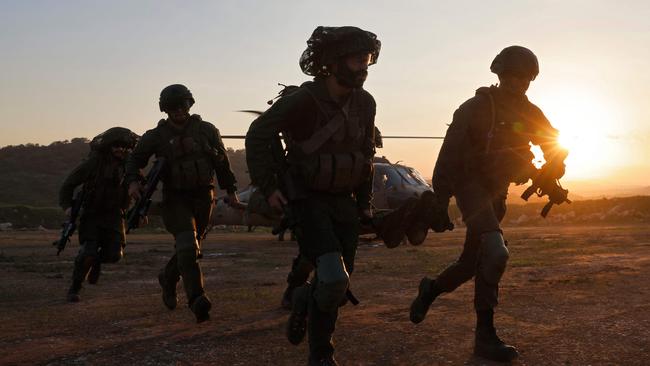
Many are quick to blame Israeli Prime Minister Benjamin Netanyahu for the thousands killed as Israel’s army tries to destroy Hamas. Yet they baulk at demanding the surrender of Hamas’s fighters hiding in tunnels under schools and hospitals. Nor do they demand the release of the remaining 132 Israeli civilian hostages still held by Hamas.
Neither do they seem troubled by the lives of luxury that Hamas’s billionaire leaders are enjoying in the Qatari capital of Doha. They don’t even ask why Hamas does nothing to help its own civilians and leaves their food, water and power supply to Israel and foreign aid organisations.
They worry about a Palestinian generation radicalised by Israel’s war but offer no comment on the radical United Nations school curriculum that for 20 years has inculcated Palestinian children with the glorification of terrorism against Israel.
This column quoted Egyptian journalist Ibrahim Eissa, editor in chief of the Cairo daily, Al Tahrir, on November 7, speaking of Hamas. “Sixteen years you engaged the Palestinian people in seven or eight wars and you didn’t even make one tunnel for them. You could have saved infants … from certain death. So who is committing crimes against the Palestinian people?”
It’s not just Hamas betraying Gaza. It is the UN Relief and Works Agency we now know allowed Hamas to set up its computerised command and control centre directly below the UN’s own computer system in the UN’s headquarters in Gaza City.
UNRWA is the same group that last month had to sack several staff and launch an investigation into the 12 UN-paid workers who crossed into Israel on October 7, when Hamas fighters killed Jewish children, women and old people in their homes, and then raped and massacred young women at a dance festival for peace.
Even now much of the Western media downplays the role of the UN in the plight of ordinary Gazans. Many reporters have been far more interested in the false Hamas narrative that Israel is deliberately killing Gazan journalists.
Such reporters seldom ask tough questions of the UN or Hamas. They reserve their scepticism for Israel, a country a tenth the size of Victoria with nine million people.
Readers interested in whether Israel has targeted Gazan reporters can download a study from independent UK-based investigative journalist David Collier on his website david-collier.com. The 150 page study, “The ‘Journalists’ of Gaza: A modern-day antisemitic conspiracy theory promoted by mainstream media”, has been largely ignored by media here apart from a two-part piece in Quadrant magazine last month.
Collier looked at journalists who died before January 4. He checked the social media accounts of the 107 who Palestinian media sources claimed had been killed for their work. He found 100 accounts.

The American NGO, the Committee for Protecting Journalists, claimed to have verified 70 of the 107. Collier found half the CPJ list actually worked for Hamas or Islamic Jihad terror channels in Gaza. The original Hamas list often reported here without scepticism included double-ups, workers who did jobs in the media that were not journalism and others who had no media connection.
Why would news organisations that reported – uncritically – claims of targeting of journalists ignore the truth when it is laid out? The Nine-owned newspapers, The Age and The Sydney Morning Herald, did it again on Friday.
A similar example: try finding Australian reports of the revelation by the Jerusalem Post on February 11 that Al Jazeera journalist Mohammed Wishah was until 2022 a commander in one of Hamas’s anti-tank missile units. Wishah is shown in photos the IDF found on his abandoned laptop training other Hamas fighters to use missiles.
Nor did our media show interest in the Times of Israel story on February 14 of a second Al Jazeera reporter, Ismail Abu Omar, injured in Rafah. He turns out to be a Hamas commander who filmed himself on October 7 inside Israeli Kibbutz Nir Oz.
For too many Western journalists, anything released by Israel’s democratically elected government is treated with scepticism. Yet most information released by ministries inside Gaza on casualties, deaths and food shortages is reported largely unchallenged, even though such information comes from Hamas.
Why? At least part of the answer lies in the trust journalists place in the UN and UNRWA. We saw a similar misplaced trust in the UN’s World Health Organisation in 2020 when it flatly refused in the first year of the Covid pandemic to challenge claims the virus came from a wet market in China.
In much modern journalism, national governments are mistrusted but multilateral bodies believed. This is why there has been so little reporting here of the Hamas control centre under UNRWA’s headquarters, a story given huge prominence in the US. ABC hosts have been more prepared to ask politicians why suspended aid to UNRWA over the October 7 allegations should not be resumed immediately than to ask about UNRWA’s close ties to Hamas.
You can see why Israelis and many Jews see much foreign reporting as deeply anti-Semitic.
Israeli newspapers last week reported the testimony of Gazan civilians complaining about Hamas leaders stealing aid from UNRWA, and even killing civilians who have complained to UNRWA about Hamas aid theft. Such stories don’t run here.
As Israel nears the completion of its war goals to remove Hamas and save as many hostages as possible, what to make of attempts, including last Thursday by Australian Prime Minister Anthony Albanese, to prevent the IDF moving in to the southern Gaza city of Rafah?
Israel has already briefed the Egyptian government on plans to evacuate civilians to 15 separate sites, each with 25,000 tents. The camps will be north of Rafah and along the western edge of the Gaza Strip near the sea. Albanese must know this.
Egypt has built a large wall across its northern border to prevent fleeing Palestinians entering. Analysts in Israel suspect much of the international concern about the clearing out of Rafah’s final four Hamas divisions centres less on concern for civilians and more on potential embarrassment as tunnels that have allowed Hamas’s leadership for years to flee Gaza via Egypt and to smuggle in weapons are discovered.
CNN on February 13 reported the extended Egyptian border wall and associated new barbed wire emplacements as a defence against possible refugee spill-over from Rafah. The Times of Israel two days earlier noted Egypt had deployed 40 tanks and armoured personnel carriers to the border and had been fortifying the border wall in December and January.
The paper said the border wall had been built 6m into the ground and was part of an effort by Egypt to address Israeli concerns about Hamas arms smuggling.
Expect Australian journalists to be incurious. But former IDF spokesman Jonathan Conricus had a point last week: “As both Egypt and the US are ratcheting up pressure on Israel not to take Rafah, it makes you wonder what embarrassing evidence Israeli combat engineers may find in the tunnels from Egypt to Gaza. Only one way to find out and my guess is that soon we will.”








Most thoughtful people lament the suffering of Gaza’s Palestinian civilians.